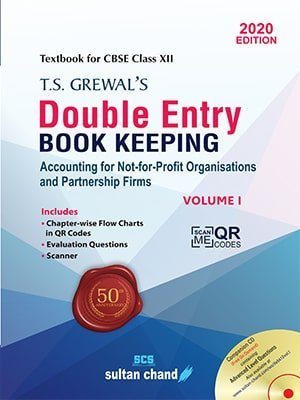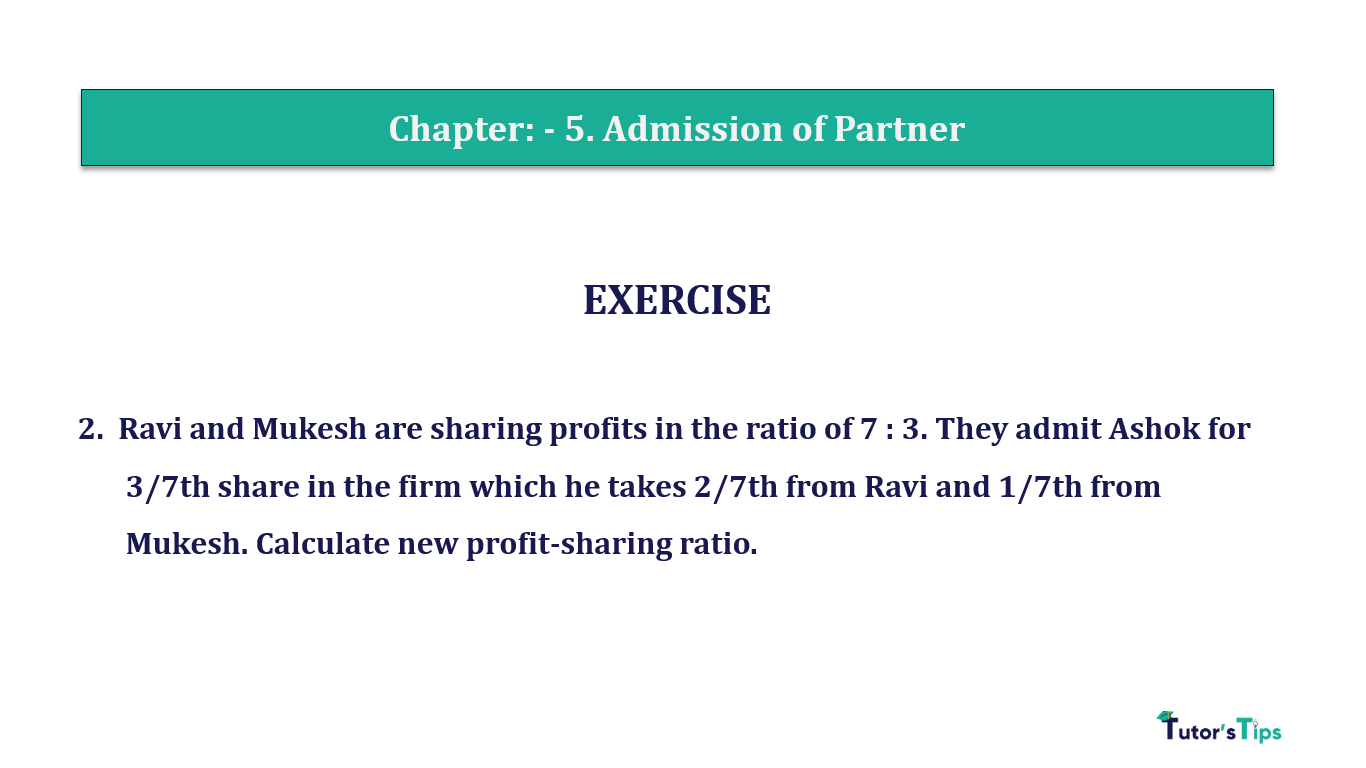Question 39 Chapter 2 of +2-A
39. Moli and Bholi contribute 20,000 and 10,000 respectively towards the capital. They decide to
allow interest on capital @ 6% p.a. Their respective share of profits is 2 : 3 and the net profit
for the year is 1,500. Show the distribution of profits:
(i) Where there is no agreement except for interest on capitals; and
(ii) Where there is an agreement that the interest on capital as a charge.
The solution of Question 39 Chapter 2 of +2-A:
Calculation of Interest on Moli’s and Bholi’s Capital
Interest on Capital = Opening Capital X Rate of Interest
| Interest on Moli’s Capital | = | 20,000 | X | 6 |
| 100 | ||||
| Interest on Moli’s Capital | = | 1,200/- |
| Interest on Bholi’s Capital | = | 10,000 | X | 6 |
| 100 | ||||
| Interest on Bholi’s Capital | = | 600/- |
| Total Interest on Capital | = | 1,200 | + | 600 |
| Total Interest on Capital | = | 1,800 |
Case I
In this case, we have to provide an amount of interest on capital up to the amount of profit because there is no agreement between partners about interest on capital. So, that’s why we have to calculate the ratio of a partner’s interest in the capital
|
Period |
The ratio of Moli’s Interest on Capital |
The ratio of Bholi’s Interest on Capital |
| Interest on Capital | 1,200 | 600 |
| Ratio of interest on Capital |
2 | 1 |
| Interest on Capital | = | Total Interest on Capital or up to the amount of Profit | X | The ratio of a partner’s interest in the capital |
| Interest on Moli’s Capital | = | 1,500 | X | 2 | |
| 3 |
Interest on Moli’s Capital = 1,000/-
| Interest on Bholi’s Capital | = | 1,500 | X | 1 |
| 3 |
Interest on Bholi’s Capital = 500/-
Case II
Advertisement-X
In this case, we have to provide a full amount of interest on capital because there is an agreement between partners about interest on capital. So, that’s why we have to calculate the share of loss of all partners.
Calculation of Interest on Moli’s and Bholi’s Capital
| Interest on Capital | = | Opening Capital | X | Rate of Interest |
| Interest on Moli’s Capital | = | 20,000 | X | 6 |
| 100 |
Interest on Moli’s Capital = 1,200/-
| Interest on Bholi’s Capital | = | 10,000 | X | 6 |
| 100 |
Interest on Bholi’s Capital = 600/-
| Total Interest on Capital | = | 1,200 | + | 600 |
| Total Interest on Capital | = | 1,800 |
Calculation of Loss transferred to Moli’s and Bholi’s Capital’s account
| Net Profit/Loss | = | Net Profit | – | Total Interest of Capital |
| Net Profit/Loss | = | Net Profit/Loss | – | 1,800 |
| Net Profit/Loss | = | 300/- |
| Loss Transferred to Moli’s Capital A/c | = | 300 | X | 2 |
| 5 |
Loss Transferred to Moli’s Capital A/c= 120/-
| Loss Transferred to Bholi’s Capital A/c | = | 300 | X | 3 |
| 5 |
Advertisement-Y
Loss Transferred to Bholi’s Capital A/c = 180/-
Thanks, Please Like and share with your friends
Comment if you have any questions.
Advertisement-X
Also, Check out the solved question of previous Chapters: –
T.S. Grewal’s Double Entry Book Keeping +2 (Vol. I: Accounting for Not-for-Profit Organizations and Partnership Firms)
- Chapter No. 1 – Financial Statement of Not-For-Profit Organisations
- Chapter No. 2 – Accounting for Partnership Firms – Fundamentals
- Chapter No. 3 – Goodwill: Nature and Valuation
- Chapter No. 4 – Change in Profit-Sharing Ratio Among the Existing Partners
- Chapter No. 5 – Admission of a Partner
- Chapter No. 6 – Retirement/Death of a Partner
- Chapter No. 7 – Dissolution of a Partnership Firm
T.S. Grewal’s Double Entry Book Keeping (Vol. II: Accounting for Companies)
- Chapter No. 8 – Company Accounts – Accounting for Share Capital
- Chapter No. 9 – Company Accounts – Issue of Debentures
- Chapter No. 10 – Redemption of Debentures
T.S. Grewal’s Double Entry Book Keeping (Vol. II: Accounting for Companies)
- Chapter No. 1 – Financial Statements of a Company
- Chapter No. 2 – Financial Statement Analysis
- Chapter No. 3 – Tools of Financial Statement Analysis – Comparative Statements and Common- Size Statements
- Chapter No. 4 – Accounting Ratios
- Chapter No. 5 – Cash Flow Statement
Check out T.S. Grewal +2 Book 2020@ Official Website of Sultan Chand Publication








Leave a Reply